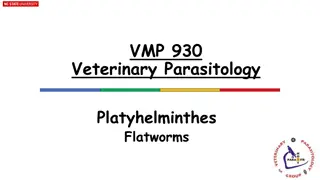Understanding Tapeworms in Veterinary Parasitology
This comprehensive guide delves into the world of cestodes, focusing on tapeworms. From the general characteristics of flatworms to the intricate life cycle of cestodes, including their presence in large and small animals, this resource provides valuable insights. Explore the morphology of different
7 views • 24 slides
Understanding Flatworms and Roundworms in Veterinary Parasitology
This comprehensive content explores the world of flatworms and roundworms in veterinary parasitology. It covers various classes such as Turbellaria, Monogenea, Trematoda, and Cestoda, detailing their characteristics, importance in veterinary medicine, and complex life cycles. The content touches on
1 views • 34 slides
Understanding Anthelmintics: Drug Therapy for Parasitic Worm Infections in Veterinary Medicine
Anthelmintics are essential drugs to combat parasitic worm infections in animals. They work either by killing (vermicide) or expelling (vermifuge) the worms, reducing worm burdens and controlling infections. This comprehensive overview covers different aspects of anthelmintics, including their prope
2 views • 34 slides
Overview of Animal Kingdom's Phyla and Characteristics
Animals in the Kingdom Animalia have diverse characteristics and are classified into different phyla based on specific traits and features. This includes Porifera (sponges), Cnidaria (jellyfishes), Platyhelminthes (flatworms), Nematoda (roundworms), Annelida (earthworms), Mollusca (snails, octopus),
0 views • 10 slides
Anatomy and Biology of Class Digenea Digenia Adult Flukes
Digenea Digenia, a class of parasitic flatworms, have distinctive anatomy and biology. Adult flukes possess two suckers, oral and acetabulum, and exhibit different types based on sucker positioning. Their tegument consists of two zones, with various chemicals for survival. The alimentary tract is in
0 views • 14 slides
Hammerhead Worms: Invasive Species Identification and Overview
Invasive terrestrial flatworms known as Hammerhead Worms, including species like Bipalium spp. and Diversibipalium multilineatum, have been introduced to various regions, likely through soil or potted plants. Five invasive species have been identified, each with distinct characteristics and sizes. W
0 views • 9 slides
Understanding Paragonimus westermani and Gastrodiscoides hominis Infections
Paragonimus westermani and Gastrodiscoides hominis are parasitic flatworms that infect humans primarily through the consumption of raw or undercooked crabs and crayfish. They can cause serious respiratory and CNS complications. The adult worms have distinct morphological characteristics and a comple
0 views • 29 slides
Understanding Cestoda: The Tapeworms in Platyhelminthes
Cestoda, a class of parasitic flatworms in the phylum Platyhelminthes, have a unique body structure with a scolex, neck, and segmented strobila. These tapeworms lack a digestive tract, absorbing nutrients through their body. They are hermaphrodites, with male and female reproductive organs in the sa
0 views • 12 slides
Understanding Platyhelminthes: Characteristics and Adaptations
Platyhelminthes, also known as flatworms, exhibit a dorsoventrally flattened body with bilateral symmetry. They can be endoparasites or free-living organisms, with some displaying unique adaptations for attachment and survival. These acoelomate organisms lack a complete digestive system, excreting w
0 views • 6 slides








